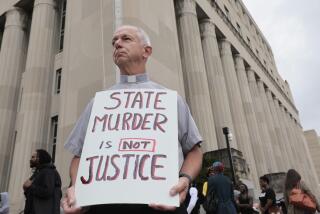Support for the Death Penalty Slowly Draining Away
- Share via
Twenty years ago, the state and national attitude toward the death penalty was overwhelmingly favorable. Victims’ rights groups, prosecutorial associations, peace-officer unions and conservative law professors all held that rehabilitation was a flop and criminals must be punished to the max. This was after state Sen. George Deukmejian had collected legislative support to restore the death penalty in California, following the U.S. Supreme Court ruling that there were conditions under which capital punishment could be lawfully applied. By 1986, support for the ultimate penalty reached an all-time high.
That support is falling. In fact, as one expert puts it, “For 20 years, no one would touch the thing. Now, among the public, and particularly, among the politicians, opposition has almost become respectable.”
What has changed? The poll numbers, for one thing. As of this year, popular support for the penalty has dropped dramatically. According to a January poll by the Public Policy Institute of California, this state’s population is split on the issue, with 47% opposing and 49% supporting the death penalty. A July Field poll found support in California dropping from 85% to 63% since the penalty’s reintroduction. “That’s a major hit for us,” says Mike Farrell, founder and head of Death Penalty Focus, an anti-death-penalty group. More impressive is that, according to the same poll, three of four Californians now question the punishment’s fairness and would support a moratorium until DNA testing and other forms of review could be done. Even 62% of polled Republicans agreed to the moratorium proposal.
Fairness is the key issue behind the change of heart on the death penalty. Twenty years ago, the country had just been through a decade of lurid serial killings, beginning with Charles Manson. The overall crime rate was rapidly rising. The death penalty was the sine qua non of the tough-on-crime movement, and Hollywood responded with a series of movies featuring freelance executioners, who, as portrayed by Charles Bronson and Clint Eastwood, never killed the wrong guy. Soon, most Americans, in and out of law enforcement, seemed to feel that the legal system also knew a murderer whenever it tried one. In California, it was hard to get elected to statewide office, or in the case of Chief Justice Rose Bird and two of her colleagues, to continue to hold office unless you heartily supported the supreme penalty.
Nowadays, though, whether the death penalty is humane or moral is less an issue than whether it’s fairly administered, something rarely considered in the Dirty Harry era. Ironically, the long-growing, popular distrust of government that was, along with tougher penalties, widely associated with the conservatism of the Ronald Reagan era seems linked to the new doubts about the death penalty. If you can’t trust the government to run Amtrak at a profit, how can you trust courts to truly ascertain guilt in every capital case?
Although California has, with more than 560 condemned individuals, the largest death-row population in the nation, the real breakthroughs in the reassessment of the death penalty began elsewhere. Particularly important was a landmark Northwestern University study in 1998. The study revealed the inconsistent, not to say occasionally sloppy, jurisprudence widespread in capital-crime convictions in Illinois. One man, Anthony Porter, had spent 15 years on death row before his innocence was proved by the efforts, in part, of journalism students. Thirteen death-penalty convictions had been overturned in 20 years, compared with 12 people executed, a ratio that strongly suggested there was something wrong with how the defendants had been convicted. These findings helped persuade the state’s GOP governor, George Ryan, to declare a two-year fact-finding moratorium on executions over the objections of the Illinois legislature.
Last month, a New York Times survey again questioned, in a comparison of death-penalty versus non-death-penalty states, whether the punishment even deterred crime. Meanwhile, DNA testing has become generally accepted as conclusive in identifying suspects. According to one federal report, 28 rape convictions have been overturned since DNA tests came into use.
So far, there has been no movement in the California Legislature to seek a moratorium on executions. But Gov. Gray Davis, perhaps the state’s most pro-death-penalty elected Democrat, recently signed into law a bill, by state Sen. John Burton, that permits DNA testing on behalf of convicted criminals.
Perhaps the most newsworthy event in the movement to stop executions until the system can be thoroughly reviewed was Texas Gov. George W. Bush’s 30-day stay of the execution of convicted killer Ricky McGinn. Bush previously had signed 131 death warrants, giving each case about 15 minutes of consideration, according to one news account. Although McGinn was executed, Bush’s campaign-season clemency showed that even on the Republican side, judicial killing is losing its appeal.
In his conclusions to the Northwestern study, Attorney Leigh B. Bienen argued that “The quality of justice in the trial and appeal cases in Illinois is of a deplorably low standard.” California’s death-row defenders contend that the state’s court system is fair when administering the punishment. But even if this were true, the federal appeal process has been recently encumbered with a law that forbids review of cases.
Meanwhile, as tales of corrupt judges, sleeping defense attorneys, technicality-based appeal denials and barricaded avenues of appeal pile up, according to one expert, “More and more people are going to look at this and say ‘Hey, this is troubling.’ ”
That should mean trouble for California’s 23-year-old death penalty. *
More to Read
Get the L.A. Times Politics newsletter
Deeply reported insights into legislation, politics and policy from Sacramento, Washington and beyond. In your inbox three times per week.
You may occasionally receive promotional content from the Los Angeles Times.










